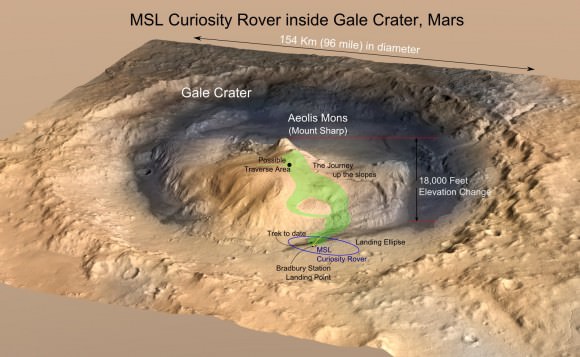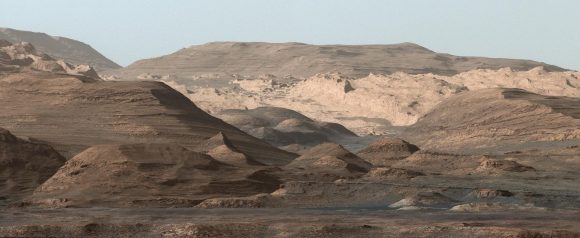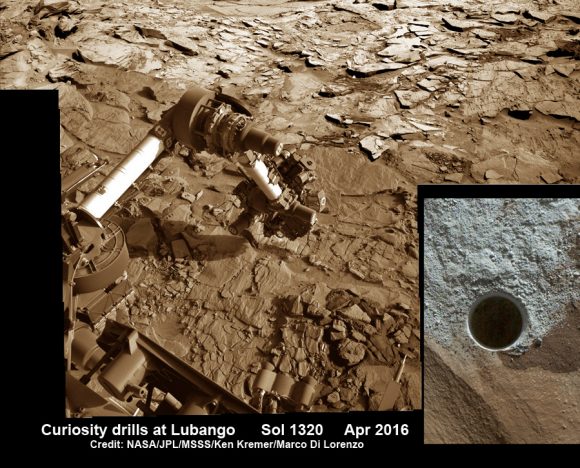On August 5th, 2012, after spending over 8 months in space, NASA’s Curiosity rover landed on Mars. As part of the NASA Mars Science Laboratory (MSL) mission, and the latest in a series of rovers deployed to the Martian surface, Curiosity had some rather ambitious research goals. In addition to investigating Mars’ climate and geology, the rover was also tasked with revealing more about Mars’ past and determining if it ever supported microbial life.
And recently, the Curiosity rover hit another major milestone in its exploration of the Red Planet. As of January 26th, 2018 the rover has spent a total of 2,000 days on Mars, which works out to 5 years, 5 months and 21 days – or 1947 Martian days (sols). That’s especially impressive when you consider that the mission was only meant to last 687 days (668 sols), or just little under 2 years.
In all that time, the Curiosity rover has accomplished some major feats and has the scars to prove it! Some of it’s wheels have become teared, holed and cracked and its drill has been pushed almost to the point of breaking. And yet, Curiosity is still hard at work pushing itself up a mountain – both literally and figuratively! The rover has also managed to exceed everyone’s expectations.
MRO image of Gale Crater illustrating the landing location and trek of the Rover Curiosity. Credits: NASA/JPL, illustration, T.Reyes
“In terms of challenges, the first 2000 days of Curiosity’s mission went better than I could have hoped. For much of the time, the rover remained as capable as the day it landed. We had a scare in the first year when a memory fault triggered additional problems and nearly resulted in the loss of the mission. We famously wore down our wheels pretty early, as well, but since then we’ve kept that under control. In the last year, we’ve had a major problem with our drill. That’s the only major issue currently, but we believe we’ll be back to drilling in a month or so. If that works out, we’ll amazingly be back to having all systems ready for science!”As of the penning of this article, the rover is climbing Mount Sharp in order to collect further samples from Mars’ past. Also known as Aeolis Mons, this mountain resides in the center of the Gale Crater where Curiosity landed in 2012 and has been central to Curiosity’s mission. Standing 5,500 meters (18,000 ft) above the valley floor, Mount Sharp is believed to have formed from sediment that was slowly deposited by flowing water over billions of years.
This is all in keeping with current theories about how Mars once had a denser atmosphere and was able to sustain liquid water on its surface. But between 4.2 and 3.7 billion years ago, this atmosphere was slowly stripped away by solar wind, thus turning Mars into the cold and desiccated place that we know today. As a result, the study of Mount Sharp was always expected to reveal a great deal about Mars’ geological evolution.
Image of Mount Sharp taken by the Curiosity rover on Aug. 23rd, 2012. The layers at the base of Mt. Sharp show the geological history of Mars. Credit: NASA/JPL-Caltech/MSSS.
“NASA’s charge to our mission was to determine whether Mars ever had conditions suitable for life,” said Vasavada. “Success was not a foregone conclusion. Would we arrive safely? Would the scientific instruments work? Would the area we chose for the landing site hold the clues we were looking for? For me, meeting each of these objectives are the highlights of the mission. I’ll never forget witnessing the launch, or nervously waiting for a safe touchdown. Discovering an ancient, freshwater lake environment at Gale crater was profound scientifically, but also was the moment that I knew that our team had delivered what we promised to NASA.”
Basically, by scaling Mount Sharp and examining the layers that were deposited over the course of billions of years, Curiosity is able to examine a living geological record of how the planet has evolved since then. Essentially, the lower layers of the mountain are believed to have been deposited 3.5 billion years ago when the Gale Crater was still a lakebed, as evidenced by the fact that they are rich in clay minerals.
The upper layers, meanwhile, are believed to have been deposited over the ensuing millions of years, during which time the lake in the Gale Crater appears to have grown, shrunk, disappeared and then reappeared. Basically, by scaling the mountain and obtaining samples, Curiosity will be able to illustrate how Mars underwent the transition from being a warmer, wetter place to a frozen and dry one.
Image taken of drill sample obtained at the ‘Lubango’ outcrop target on Sol 1320, Apr. 23, 2016. Lubango is located in the Stimson unit on the lower slopes of Mount Sharp inside Gale Crater. Credit: NASA/JPL/MSSS/Ken Kremer/kenkremer.com/Marco Di Lorenzo
“Curiosity established that Mars was once a suitable home for life; it had liquid water, key chemical building blocks, and energy sources required by life in the lake and groundwater environment within Gale crater. Curiosity also has detected organic molecules in ancient rocks, in spite of all the degradation that could have occurred in three billion years. While Curiosity cannot detect life itself, knowing that Mars can preserve organic molecules bodes well for missions that will explore ancient rocks, looking for signs of past life.”At this juncture, its not clear how much longer Curiosity will last. Considering that it has already lasted over twice as long as originally intended, it is possible the rover will remain in operation for years to come. However, unlike the Opportunity rover – who’s mission was intended to last for 90 days, but has remained in operation for 5121 days (4984 sols) – Curiosity has a shelf life.
Whereas Opportunity is powered by solar cells, Curiosity is dependent on its Multi-Mission Radioisotope Thermoelectric Generator (MMRTG). Eventually, this slow-fission reactor will exhaust its supply of nuclear fuel and the rover will be forced to come to a halt. And considering how the rover has been put through its paces in the past 5 years, there’s also the chance that it will suffer a mechanical failure.
But in the meantime, there’s plenty of work to be done and lots of opportunities for vital research. As Vasavada put it:
“Curiosity won’t last forever, but in the years we have left, I hope we can complete our traverse through the lowermost strata on Mount Sharp. We’re well over halfway through. There are changes in the composition of the rocks ahead that might tell us how the climate of Mars changed over time, perhaps ending the era of habitability. Every day on Mars still counts, perhaps even more than before. Now every new discovery adds a piece to a puzzle that’s more than halfway done; it reveals more given all the other pieces already around it.”And be sure to check out this retrospective of the Curiosity rover’s mission, courtesy of NASA:
Further Reading: Forbes, NASA
The post Curiosity has Lasted More than 2,000 Days on Mars, Triple its Original Mission Plan appeared first on Universe Today.



No comments:
Post a Comment